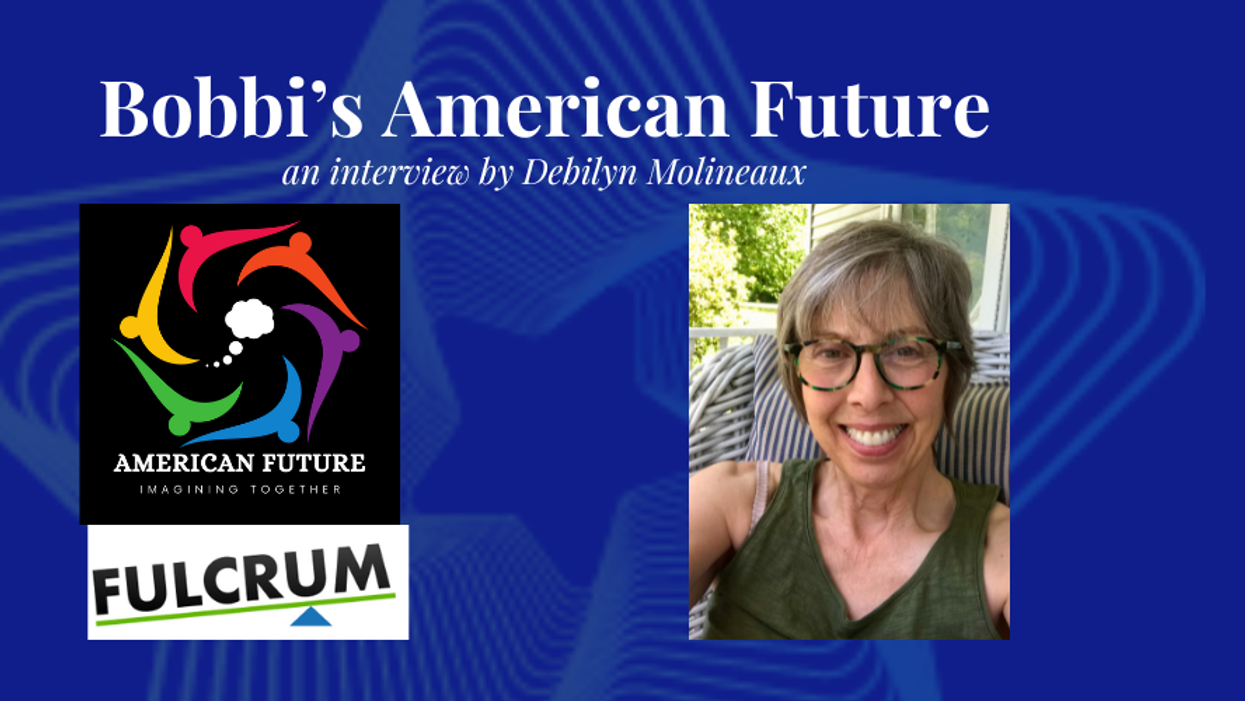This is part of a weekly series of interviews by Debilyn Molineaux, project director for AmericanFuture.US. The project's mission is to help everyday Americans to imagine a better future for themselves, and together we’ll write the next chapter of the United States of America.
The conversation with Bobbi Bennett took place on Oct. 15, 2023. We met in a meditation class in 2020 and continue to be sangha members, meeting weekly on Zoom. The interview has been lightly edited for clarity.
Debilyn Molineaux: We are going to time travel today – within your current life. How far would you like to imagine together? We recommend somewhere between two and 20 years. What sounds right for you?
Bobbi Bennett: Ten years – I’ll be 79 then.
DM: Let’s take a few deep breaths as the time machine takes us to this imagined future. I would like you to observe yourself there and respond to these questions. Where are you in 10 years?
BB: I suspect I’ll be in California. But if I’m demented, I’m heading for Costa Rica and the Karuna community there.
DM: What will you be most proud of with your 79-year-old self?
BB: My inner peace, the comfort and ease of my direct experience of myself and the world. That I’ve been helpful and useful. My prime directive has always been that I just want to help. I am satisfied that I’ve done that, no matter how small or big.
DM: What are some ways you’ve been helpful?
BB: I’ve been having memories of where I missed a diagnosis or didn’t manage something well, but I’m also remembering some really excellent care I delivered. Feeling like I did make a difference for some people. I helped my family – I helped my dad pass. He was a difficult person, and that experience was very tender. Since I’m in California, it means I’ve been helping my daughter with her kids. And helped my other daughter with her life. She’s had a difficult life, and I continue to be a support for her.
DM: How will you spend your day?
BB: Karuna will be thriving and a huge part of my life. I feel very strongly about it. I want to become a teacher. As an older person, I don’t know how that works out. Because now, I spend a big part of my day in meditation, reading. I’ve been having a lot of joy, actually making relationships with people in Karuna. I’m continuing to strengthen those bonds. Physical activity is part of my life, I have to keep moving. I like creativity. I like knitting. Another thing that is coming up is maybe painting more or taking classes. Within the Karuna community, I embody the role of the elder in a wisdom position.
DM: How will you feel, most of the time?
BB: Good. I feel good most of the time now and I’m assuming that won’t change. What that means is I’m in love with things. That’s why I would be a good wisdom figure or cheerleader or ambassador. This practice has changed my life. Not that I wasn’t happy before. I’ve always been an optimistic person. I remember when I had adolescent onset scoliosis and I had a lot of shame associated with it. I remember talking with a boyfriend, telling him I didn’t want to have kids because they might develop scoliosis.
And then all of a sudden I realized that kind of thinking would have made me miss my own life, and what a shame, because my life had been a blast! I’ve really enjoyed my life – I’ve had really hard challenges, but I’ve also had beautiful peak experiences. I actually like my mind. It’s been very lively my whole life. I was also fairly anxious all my life. And my religion/faith beliefs, I’ve definitely wrestled with these things. Then in 2011 I got on the Buddhist path with Dan Brown and John Churchill, and it has been steady improvement since. I’ve even found a way to include and transcend my conflicted early religious beliefs (with some help from a fellow sangha member). I have a lot of joy. Even with the disheartening things in the world, I feel like it’s workable, somehow.
DM: What will be your three priority values in 2033?
BB: First, good relationships that are based in love and connection to each other. Second, to hold equanimity until death. This involves my practice to meet death with enlightenment and hold it – to hold myself in equanimity. Earlier in life, all my anxiety was around “oh my god, I’m going to die.” Third will be service. For my essence to be of benefit to others – that somehow being connected to me would turn out to be a good thing for people. This is also servant leadership or stewardship. Yes, those words resonate for me.
DM: What does the community that supports your future need to include?
BB: The community that supports me needs to have “right relationship” as a core organizing principle, along with a commitment to healing the wounds of the Earth (this includes, but is certainly not limited to, all of humanity). This is why the Karuna community is so important to me. I have an intuition that I have found my people.
DM: Is there anything you can do today or in the near future to influence or co-create the community that will support you in 2033?
BB: I am committed to co-creating the Karuna community. This is why I can’t give specific details about what I will actually be doing, or what my life will look like, apart from breathing life into and embodying the organizing principles at this point - all of my sangha mates will be sharing their minds and ideas, and together we will see what emerges <3
DM: I also extend an invitation to spend five minutes every day thinking about your future self, feeling those feelings and include a sense of awe and wonder. This is based on neuroscience research that shows we subconsciously create what we focus on. So the choice is ours – we can actually co-create the future we prefer instead of choosing from the dystopian options presented to us.
BB: Amen and Aho, Debilyn!



















